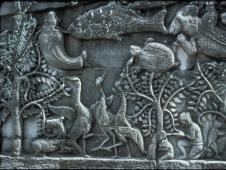
The total annual value of nature’s services in gross monetary terms has been estimated at $33 trillion (in year-1997 US$). However, ecosystem services are not yet widely valued in many societies and people are not yet widely aware that the sum of their actions as individual consumers is often a leading cause of ecosystem degradation. Improving knowledge of ecosystem services is a priority if policies are to change and the world is to shift towards more sustainable forms of development.
Biodiversity, in the sense of ecosystems and their interaction with the non-living world, provides numerous services to humanity, such as climate regulation, soil fertility, crop pollination and water purification (Daily 1997). These processes nevertheless remain outside the calculations of conventional market-based economics that have guided models of human development. Widespread degradation of ecosystems in recent decades has prompted concern among conservation scientists that enormously valuable assets to humanity are being lost in the pursuit of short term private wealth, partly through such ecosystem services being undervalued or ignored. Hence an attempt to calculate the total annual value of nature’s services in gross monetary terms, which extrapolated from an assessment of 17 ecosystems spread over 16 biomes, to make a best estimate of $33 trillion (in year-1997 US$; Costanza et al. 1997).
Although ‘nature’ is increasingly appreciated, ecosystem services are not yet widely valued in many societies, especially in highly urbanised regions and in industrialised nations where people are no longer directly subsistent upon their local ecosystem. For example, a survey that monitors citizens. environmental awareness in the USA has found that environmental ‘illiteracy’ remains widespread amongst the general public, despite good progress over the last 30 years in addressing national environmental problems at the levels of government, corporations and municipalities (NEETF 2000). People are not yet widely aware that the sum of their actions as individual consumers is often a leading cause of ecosystem degradation, through driving such processes as climate change and biodiversity loss (NEETF 2000). Improving knowledge of, and access to, information on ecosystem services at the grassroots level is a clear priority if policies are to change and the world is to shift towards more sustainable forms of development.
Related Case Studies in other sections
References
Compiled: 2004 Copyright: 2004
Recommended Citation:
BirdLife International (2004)
How much do we value wild nature?.
Downloaded from https://datazone.birdlife.org/sowb/casestudy/how-much-do-we-value-wild-nature on 22/12/2024